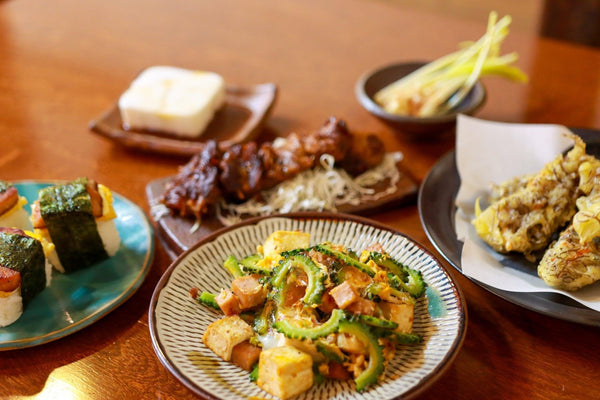
Jump to:
Okinawan cuisine holds a unique place in the overall genre of Japanese food. Okinawa has an identity, which it appears keen to maintain, of being part of Japan yet separate at the same time. It has developed a culture separate from the mainland, and this has also been reflected in the development of its food culture and diet.
In this article, we shall look at the history of Okinawan cuisine, its characteristics, and look at western influences on traditional Okinawan food. We shall then explore what truth there is behind the commonly held belief that Okinawan food is healthy. Following that, we shall discuss commonly eaten Okinawan dishes and beverages, as well as introduce you to some popular Okinawan snacks and desserts, before rounding up with a quick look at some “must-visit” restaurants in Okinawa.
History Of Okinawan Food

Okinawa was an independent country, called the Ryukyu Kingdom, until the so-called “Satsuma invasion“ in 1609, in which Ryukyu was placed under the control of the Japanese shogunate. Until then, its food culture had been shaped more by trading with China than with the Japanese mainland, and sweet potatoes, which it got from China, became entrenched as the staple carbohydrate in the diet, unlike rice elsewhere in Japan. Geographical factors also contributed to this and the seasonal storms that batter Japan on a seasonal basis made rice growing difficult.
Additionally, unlike the Japanese mainland where there was a taboo on eating meat until the 19th Century, a strong meat-eating culture has always been prevalent in Okinawa, especially in regard to pork (there is a saying that “Okinawans eat every part of the pig but its squeal”). Despite being an island nation, before the days of refrigeration, eating raw fish was not practical due to the island’s higher temperatures, and so where seafood was eaten, it tended to be pickled, grilled, or boiled (in salt using a technique known as “masu-ni”).
Characteristics Of Okinawan Food

Traditional Okinawan cuisine can be classified into three types of Kyutei-ryori (“court cuisine”), Shomin-ryori (commoner cuisine), and Gyoji ryori (event cuisine).
These different types are all prevalent today. Kyutei-ryori dates back to when Okinawa was trading with the Ming dynasty and entertained foreign dignitaries. Exquisite lacquerware boxes are used to serve small portions of food, typically tofu, pork, tropical vegetables, and seafood. In the case of Shomin-ryori, rather than concentrating on beautiful presentation, the emphasis is on providing a meal that is tasty, inexpensive, and nutritious. A good example of this is Goya-
Champuru, which will be described later. Okinawa hosts large festivals and events where large numbers of people gather to pray for a good harvest or take part in memorial services, and on this occasion, Gyoji-Ryori, which often includes kamaboko (boiled fish paste) and deep-fried tofu, is served.
Traditional Okinawan food is based around certain staples, such as sweet potatoes, soy products, kelp, pork, and pickled fish. It also has tropical fruits that are available the whole year around, and these include more familiar fruits, such as bananas and mangoes, as well as native Okinawan fruits, such as the Shikuwasa (a citrus fruit similar to lime), and Tankan (a type of orange).
The Importance Of Beni Imo

As previously noted, the food culture of the early Ryukyu Kingdom was heavily impacted by overseas trade, and Beni Imo, a type of sweet potato, became entrenched as the staple carbohydrate in the diet.
Beni Imo are rich in antioxidants, B vitamins, potassium, and fiber, and are lower in calories than their equivalent weight in white rice. Traditionally, this highly nutritious starchy vegetable accounted for 80% of the calories in the Okinawan diet and formed the bedrock of their healthy diet.
For this reason, the traditional Okinawan diet used a lot less rice than was consumed in mainland Japan. However, in recent years, younger people have been eating a higher proportion of rice, which is less nutritious than the Beni Imo which had been the base starchy vegetable for so long, it is suggested that this has had a negative impact on the health of Okinawans.
Influences On Traditional Okinawan Food

The traditional Okinawan diet used a lot less rice than was consumed in mainland Japan, but in recent years younger people have been eating a higher proportion of rice, which is less nutritious than the sweet potatoes that have been the base starchy vegetable for so long.
There has also undoubtedly been an American influence on the Okinawan diet. Okinawa spent 27 years under U.S. rule from 1945 to 1972, and military bases have remained since then. One effect of this has been the increase in beef and sugar consumption, and these are seen by some Okinawans as having had a corrupting effect on the diet.
External influences have not only been negative, however, and some dishes, such as taco rice (described in more detail below), have emerged through the blending of various cultures that have added something to Okinawan cuisine.
How Healthy Is Okinawan Food?

Okinawa is considered one of the so-called “blue zones”, which are defined as areas where people are expected to live longer and healthier lives.
Okinawan food is based on the principle of “Ishoku-Dogen”(医食同源), which literally means “food and medicine from the same source”. This embraces the concept that fundamental health is primarily obtained through one’s diet
As previously noted, early trading with Japan as well as other factors led to sweet potatoes, rather than rice, being the staple food. Sweet potatoes are rich in antioxidants, B vitamins, potassium, and fiber, are and lower in calories than white rice. Traditionally, this highly nutritious starchy vegetable accounted for 80% of the calories in the Okinawan diet and formed the bedrock of their healthy diet.
Okinawans also have the highest per capita of mineral-rich kelp in Japan, and traditionally ate a lot of pork, which has high quantities of B1, effective in fighting summer fatigue in the subtropical heat of the island. Vitamin C levels are also maintained with the luscious citrus fruits available in Okinawa.
If the above is not enough to convince you that the Okinawan diet is particularly healthy, the proof of the pudding, as they say, is in the eating. In 1980, the Okinawans had the longest life expectancy among anyone in the world. By 1990, however, the average life expectancy for Okinawan men was only the fifth highest of the 47 prefectures in Japan and by 2020 had nosedived to 36th place on the list. It is no coincidence that this tracks a move to a diet more heavily influenced by that of mainland Japan and the West.
Popular Okinawan Dishes
In this section, we shall look at some popular Okinawan dishes that you will definitely want to try.
Rafute

Rafute, which is a classic Okinawan slow-cooked braised pork dish, slow-cooked in Awamori. It combines three classic Okinawan ingredients of pork, the distilled Okinawan liquor called Awamori, and black sugar (with some soy sauce thrown in to boot). You might like to try the version that uses the native Agu pork, which Okinawans claim contains more than twice the umami of regular pork.
Okinawan Soba Noodles

Okinawan soba is made from wheat flour and is usually eaten with a flavorful soup including pork ribs and bonito flakes. Okinawan soba has a very different feel to those from other areas, so you should definitely give them a try.
Goya Champuru

Goya Champuru is a great example of a dish traditionally served to the common people of Okinawa and embodying the concept of “Isshoku Dogen” just discussed. Goya (sometimes referred to as “bitter melon”) is stir-fried with tofu, egg, and pork belly, for a basic but nutrient-rich meal enjoyed by the rank and file. In addition to being delicious, it is extremely healthy, so be sure to give it a try.
Taco Rice

Taco rice is a dish that was invented in 1984 to provide a filling meal for U.S. servicemen and has now become recognized as an Okinawan dish, representing a blend of multiple cultures. As the dish consists of ground meat, cheese, lettuce, and tomatoes on a bed of white rice served with a spicy sauce, it combines Tex-Mex with mainland Japanese food. The spiciness of this dish makes it particularly enjoyable in warm weather, which is most of the time in Okinawa.
Okinawan Beverages
There is also a wide range of interesting beverages native to Okinawa for you to try and enjoy.
Awamori

If you are looking for something alcoholic on the stronger end of the spectrum, you would be wise to check out Awamori. Like sake, it is made of rice, in this case, indica rice imported from India, but unlike sake, it is distilled, which gives it a real kick. It is made in more than 30 regions of Okinawa, with each giving it a different name. If you hear the name kusu, this refers to Awamori that has been aged for 3 years. Drink with care, however, as the alcohol content can be up to 60%.
Orion Beer

If Awamori is a bit too strong for your taste, you may like to try Orion beer. Since its creation in 1959, Orion's "Draft Beer" has been constantly improved and now signifies the taste of Okinawa with its "clear and delicious" taste.
Ucchincha (tea)

If tea is more your thing, Ucchincha is an easy-to-drink tea made from turmeric, a ginger plant that has been consumed in Okinawa since the time of the Ryukyu Dynasty. Turmeric is good for improving liver and digestive functions and is definitely recommended if you have over-indulged on the Awamori or Orion beer the day before.
Shikuwasa Juice

This citrus drink has a refreshing sweet and sour flavor that many people choose to incorporate into their diet simply for its health and beauty benefits. A variety of products are available, from undiluted 100% fruit juice types to soft drinks that are designed to be easy to drink.
Okinawan Snacks And Desserts

Okinawa also has a great range of snacks and desserts, and the Japanese Taste website is the perfect place to start. These include Orion snack nuts to accompany your beer, and a whole range of snacks from Nanpudo that give you the ultra-casual dining experience of Okinawan flavors, including goya chanpuru and taco rice
Beni imo is a type of purple potato that is highly popular as a dessert in Okinawa. If you are interested in seeing what this tastes like, why not try these beni imo tarts.
Where To Eat In Okinawa
In case you are in Okinawa, and going out to eat is more your thing, you might like to try the following restaurants.
This is an Okinawan-style izakaya (or pub) where you can casually enjoy the taste of Okinawan home cooking and relax, listening to Okinawan folk songs being played as you sit in a tatami room in the style of an Okinawan private house.
This restaurant features creative cuisine using Okinawan native Agu pork, and island vegetables. Its specialty is pork, which is steamed to bring out the whole flavor without sacrificing its nutritional qualities.
This restaurant brings you the taste of Yanbaru, which is in the northern part of Okinawa’s main island. It is a particular favorite of chicken lovers and is a place to enjoy char-grilled “Yanbaru Wakadori” and “Yanbaru Jidori”, two Okinawa brands of chicken loved by the locals.
A Great Melting Pot Of Tastes
Okinawan cuisine, like Okinawan culture in general, is the amalgam of a large range of disparate forces. Heavily influenced in ancient times through its trading with China, it started off on a different course from mainland Japan and still retains many of its traditional roots. The growing influence of mainland Japan and American culture in recent decades has seen a shift in various consumption trends, and this has also resulted in the emergence of new dishes, such as taco rice, that have been added to the repertoire of Okinawan food.
The result of this is a great melting pot of tastes, that truly offers something for everyone. Do you have a favorite type of Okinawan food? Let us know in the comments.


0 comments